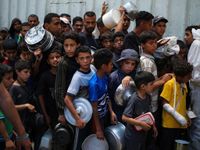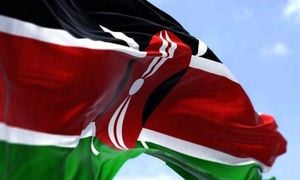On August 22, 2025, the world’s leading authority on food crises, the Integrated Food Security Phase Classification (IPC), made a declaration that sent shockwaves through international corridors: famine is occurring in Gaza City, home to hundreds of thousands of Palestinians. According to the Associated Press, this is the first time the IPC has confirmed a famine in the Middle East, marking a grim milestone in a region already battered by conflict and hardship.
The IPC’s assessment, backed by United Nations agencies and dozens of governments and NGOs, is stark. Data analyzed between July 1 and August 15, 2025, revealed that thresholds for starvation and acute malnutrition have been breached. More than half a million people in Gaza—about a quarter of its population—now face catastrophic levels of hunger, with many at risk of dying from malnutrition-related causes. The IPC warns the crisis could worsen, with famine projected to spread south to Deir al-Balah and Khan Younis by the end of September.
UN Secretary-General António Guterres didn’t mince words in response to the IPC’s findings. As reported by UN News, he called it “a man-made disaster, a moral indictment—and a failure of humanity itself.” Guterres emphasized, “Famine is not about food; it is the deliberate collapse of the systems needed for human survival.” He demanded immediate action: “No more excuses. The time for action is not tomorrow—it is now.”
The IPC determination is based on a rigorous set of criteria: at least 20% of households must be essentially starving, at least 30% of children under five suffering from acute malnutrition, and at least two people per 10,000 dying daily due to starvation or related disease. The evidence gathered, though hampered by limited access, was deemed sufficient to confirm that these thresholds have been met in Gaza City. The situation in North Gaza is believed to be just as dire, though lack of data has prevented an official classification.
Malnutrition among children is accelerating at what UN agencies call a “catastrophic pace.” In July 2025 alone, more than 12,000 children were identified as acutely malnourished—a six-fold increase since the start of the year. Doctors in Gaza’s beleaguered hospitals have reported a surge in emaciated patients. At Shifa Hospital, Ahmad Sbeteh, a 17-year-old injured by shrapnel, has lost about 15 kilograms (33 pounds) due to the lack of food and nutritional supplements, according to his doctors. His sister, Aya, just 15, has lost nearly 20 kilograms (44 pounds), or about 30% of her body weight. “Doctors say she needs protein, meat and fish,” their father, Yousef Sbeteh, told the Associated Press. “But I can’t provide that now.”
The roots of the crisis trace back to the war that erupted on October 7, 2023, when Hamas launched an attack on Israel. Since then, Israel has imposed severe restrictions on food and aid entering Gaza, tightening the blockade further from early March to mid-May 2025. While Israel’s Foreign Ministry states that more than 100,000 trucks of aid have entered Gaza since the war began—including a recent influx—aid agencies and experts argue that what gets through remains vastly insufficient. The United Nations has consistently highlighted the extreme urgency of delivering immediate and full-scale humanitarian aid, citing escalating hunger-related deaths, rapidly worsening malnutrition, and plummeting food consumption in the territory.
The Israeli government, however, categorically rejects the famine declaration. Prime Minister Benjamin Netanyahu called the IPC report “an outright lie,” stating on X (formerly Twitter), “Israel does not have a policy of starvation.” The Israeli military agency responsible for aid transfers, COGAT, labeled the report “false and biased,” insisting that significant steps have been taken to expand aid, and that there is currently no limit to the number of aid trucks allowed into Gaza. The U.S. State Department also expressed skepticism, suggesting that Hamas and looters are to blame for difficulties in delivering aid.
Yet, as UN Emergency Relief Coordinator Tom Fletcher pointed out in a press briefing, “It is a famine within a few hundred meters of food, in a fertile land. It is a famine that we repeatedly warned of—but that the international media has not been allowed in to cover, to bear witness.” Fletcher called it “a famine in 2025. A 21st-century famine watched over by drones and the most advanced military technology in history. It is a famine openly promoted by some Israeli leaders as a weapon of war.”
The devastation extends beyond food shortages. Approximately 98 percent of Gaza’s cropland is now damaged or inaccessible, decimating local food production. Nine out of ten residents have been serially displaced from their homes, and the collapse of basic infrastructure has made access to clean water and medical care a daily struggle. The IPC warns that by the end of September, more than 640,000 people will face “catastrophic” levels of food insecurity (IPC Phase 5), with an additional 1.14 million in Phase 4 and nearly 400,000 in Phase 3 crisis conditions.
UN human rights chief Volker Türk weighed in with a grave warning, stating, “It is a war crime to use starvation as a method of warfare, and the resulting deaths may also amount to the war crime of willful killing.” Türk called on Israeli authorities to “take immediate steps to end the famine in the Gaza Governorate and prevent further loss of life across the Gaza Strip. They must ensure immediate entry of humanitarian assistance in sufficient amounts, and full access to UN and other humanitarian organizations.”
The humanitarian consequences are compounded by the ongoing conflict. The IPC and UN agencies have expressed grave concern that Israel’s planned offensive to seize Gaza City and other Hamas strongholds will only exacerbate the hunger crisis. Many of the most vulnerable—sick and malnourished children, the elderly, and people with disabilities—may be unable to evacuate. Aid convoys have struggled to reach those in need, often hampered by Israeli military restrictions, incidents of looting, and the chaos of desperate crowds. Witnesses and health officials report that hundreds have been killed while trying to access aid, though Israel claims it only fires warning shots and disputes the reported tolls.
As the world watches, the question lingers: could this famine have been prevented? Alex de Waal, author of “Mass Starvation: The History and Future of Famine,” told the Associated Press that if Israel had allowed the IPC better access to collect data, the famine might have been declared months earlier, potentially spurring swifter global action. “It seems that it’s necessary for experts to shout ‘famine!’ before the world takes notice, by which time it is too late,” de Waal lamented.
With the IPC warning that a third of Gaza’s population could face catastrophic hunger by the end of September, the calls for an immediate ceasefire and unimpeded humanitarian access grow ever more urgent. For Gaza’s families, the agony of watching loved ones waste away has become a daily reality, a testament to the high human cost of war and political impasse.
The world now stands at a crossroads, confronted by the undeniable evidence of a famine unfolding in real time. Whether the international community will heed the warnings and act decisively—or allow this failure of humanity to deepen—remains to be seen.






